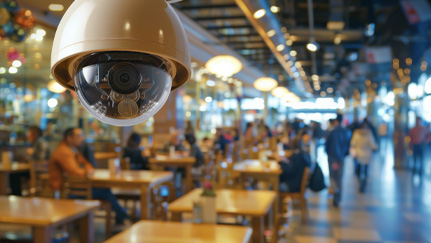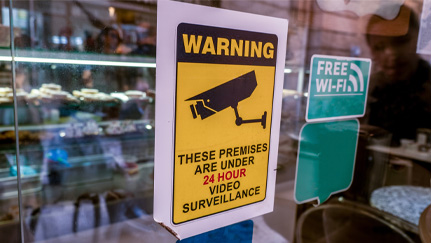Security cameras in food service facilities

In today’s fast-paced restaurant environment, ensuring the safety and security of both patrons and staff is vital. Installing security cameras not only acts as a powerful deterrent against crime and fraud but also provides invaluable peace of mind. These systems help monitor daily operations, prevent theft, and quickly resolve disputes, creating a safer and more enjoyable dining experience for everyone involved.
Conduct a risk assessment
Before purchasing and installing security cameras, conduct a thorough risk assessment to understand your restaurant’s vulnerabilities. Identify areas that require monitoring, such as entrances, exits, dining areas, kitchens, and parking lots.
Key features to consider
When selecting security cameras for a restaurant, consider these key features to ensure you get the most effective and reliable system.
- Resolution: High-definition (HD) cameras, typically with 1080p resolution or higher, provide clear and detailed footage, which is essential for identifying individuals and incidents. For even better clarity, especially in larger areas, 4K resolution cameras are recommended.
- Field of view: Security cameras with wide-angle lenses can cover larger areas, reducing the number of cameras needed. Pan-tilt-zoom (PTZ) cameras can allow remote control of the camera, offering flexible coverage.
- Low-light performance: If cameras are used during nighttime surveillance, ensure they have good low-light performance or infrared capabilities. Providing adequate lighting outside can also enhance camera image quality.
- Durability: Ensure security cameras are suitable for their intended environment. Outdoor cameras should be weatherproof and durable.
- Motion detection: Many security cameras can record footage when motion is detected, saving storage space and making it easier to review footage.
- Audio capabilities: Some security cameras have built-in microphones to capture sound, providing more context to visual footage.
Integration with other systems
Often security cameras can be integrated with other systems.
- Alarm systems: Cameras that integrate with alarm systems can trigger alerts and notifications during suspicious activities.
- POS systems: Some cameras can be integrated with Points of Sale (POS) systems to watch transactions and deter theft.
- Advanced features: Advanced cameras can include analytics and AI features, such as facial recognition or people counting. Selecting a system that allows remote access to live and recorded footage via a smartphone or computer provides an added level of convenience and efficiency.
Wired vs. wireless security cameras
Choosing between wired and wireless security cameras involves weighing the pros and cons of each type. Here is a comparison to help decide which is best for your establishment.
Wired security cameras
Pros
- Reliability: Wired cameras are generally more reliable as they are not subject to Wi-Fi interference or signal loss.
- Consistent Power Supply: These cameras draw power directly from the cable, ensuring continuous operation without the need for battery changes.
- Higher Quality Footage: They often provide higher quality video and audio since they are not limited by bandwidth.
- Security: Less susceptible to hacking since they do not rely on wireless signals.
Cons
- Installation Complexity: Can be more complex and costly, often requiring professional installation.
- Limited Flexibility: Moving wired cameras can be difficult and may require additional wiring.
- Aesthetic Impact: Visible wires can be unsightly and may require concealment.
Wireless Security Cameras
Pros
- Ease of Installation: Easier to install, often requiring only a power source.
- Flexibility: They can be easily moved and repositioned as needed.
- Remote Access: Typically offer remote viewing and control via smartphones and computers.
- Integration: Easier to integrate with other smart devices and systems.
Cons
- Signal Interference: Can suffer from signal interference and connectivity issues, especially in areas with weak Wi-Fi.
- Power Supply: Most wireless cameras still need a power source, and battery-powered options require regular maintenance.
- Security Risks: More vulnerable to hacking if not properly secured.
- Potential Costs: Cloud storage and advanced features may incur added costs.
Storage solutions
Storage solutions can include local storage and cloud storage. Local storage is the storing of video data directly within the premises, often on a hard drive, digital video recorder (DVR) or network video recorder (NVR). Cloud storage stores video footage on remote servers and can be accessed from anywhere, anytime given a steady internet connection.
Local Storage
Pros
- Immediate and direct access to footage.
- Resilience against network issues.
Cons
- Physical damage (fire or flooding) or theft can lead to irreversible loss of data.
- Maintenance and replacement cost associated with hardware.
- More hands-on management and technical expertise compared to cloud storage.
Cloud Storage
Pros
- As storage needs grow, the cloud can accommodate the growth without requiring added hardware.
- Offsite storage of footage safeguards against physical threats like theft, fire, or flooding.
- Incorporates advanced security measures such as encryption and multi-factor authentication.
- Regular updates from service providers ensures system stays updated, relieving burden of technical upkeep.
Cons
- Dependent on internet connection and service provider’s uptime.
- Recurring subscription fees can become costly.
- Third-party access to footage might pose privacy concerns.
Retention policy
Retention Policy for Security Camera Footage
Regardless of the storage method used, it is crucial to implement a clear policy on how long footage is retained during normal operations and following any notice of an incident or claim.
Best Practices
- Normal Use:We recommend retaining recorded footage for a minimum of 90 days.
- Incident/Claim Notice:Upon receiving notice of an incident or claim, save all relevant footage immediately and indefinitely. This includes footage from the period before, during, and after the event, to anticipate potential litigation. Aim to capture approximately one hour before and after the event.
- Extended Retention:Based on input from our Claims organization, consider retaining footage for up to three years if your storage solution allows for it.
By adhering to these guidelines, you can take steps to ensure that critical footage is available when needed, providing valuable evidence for any potential claims or legal matters.

Camera placement
Strategically consider the number of cameras needed and their placement:
- Quick Service and Fast Casual Restaurants: 10 cameras/1,000 square feet.1
- Full Service: 12-15 cameras/1,000 square feet, plus coverage for where alcohol is served, stored, or poured.1
Consider placing cameras in the following locations:
- Entrances/exits: One facing entrance and one facing exit of same door
- Areas where cash is handled (register/managers office)
- Parking lot and outdoor walkways
- Dining areas
- To-go pick-up stations
- Drink fountain areas
- Area where alcohol is served
- Kitchen and storage areas
- Stairwells (if the building has multiple floors)
Install cameras at a height and angle that maximizes coverage and minimizes tampering. At exits or registers, place cameras near objects (signs, monitors or televisions) to catch the attention of individuals.
Legal considerations
Be aware of privacy laws and regulations regarding surveillance in your area, especially if using cameras that capture sound. Balancing privacy concerns with the need for surveillance is crucial for supporting trust and compliance with legal requirements. Develop and communicate a clear surveillance policy to employees and ensure they understand the purpose, scope, and extent of surveillance. Inform customers about surveillance through visible signage and if necessary, through terms of service or privacy policies.
Video surveillance is an essential part of any restaurant crime prevention program. Investing in a reliable system can save money by discouraging both employee and customer theft. Security cameras also help verify the legitimacy of claims, protecting against fraudulent lawsuits and ensuring genuine incidents are addressed. Additionally, security cameras can provide evidence to law enforcement in cases of criminal activities.
Reach out to Nationwide’s Risk Management team to help with solutions in managing your risk.
1 Best restaurant security cameras and security systems in 2024 (solink.com)
The information included is designed for informational purposes only. It is not legal, tax, financial or any other sort of advice, nor is it a substitute for such advice. The information may not apply to your specific situation. We have tried to make sure the information is accurate, but it could be outdated or even inaccurate in parts. It is the reader’s responsibility to comply with any applicable local, state, or federal regulations and to make their own decisions about how to operate their business. Nationwide Mutual Insurance Company, its affiliates and their employees make no warranties about the information nor guarantee of results, and they assume no liability in connection with the information provided. Nationwide, Nationwide is on your side, and the Nationwide N and Eagle are services marks of Nationwide Mutual Insurance Company. © 2025 Nationwide
